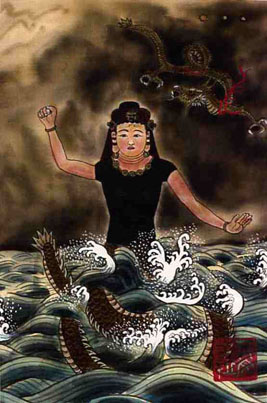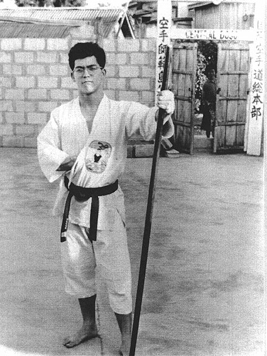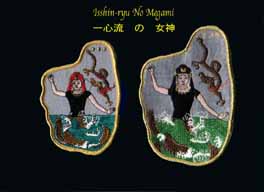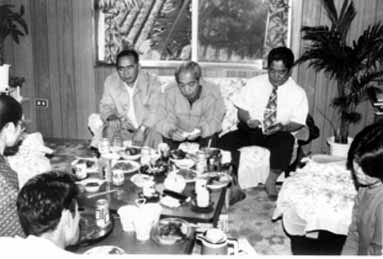The Isshin-ryu patch was conceived by Arcenio J. Advincula with Tatsuo Shimabuku's permission in February 1961. Advincula started by asking Shimabuku for his permission to design a patch. Some American students were wearing patches they designed.
|
|
|
Some wore traditional horizontal fist patches. |
Some wore patches with a Shinto Tori. |
Still others wore a patch of Okinawa with Isshin-ryu written along the side. |
None of these patches reflected the true meaning of Isshin-ryu. Advincula wanted a patch depicting Shimabuku's goddess. He drew a design showing the goddess fighting a dragon. When Shimabuku saw the design, he laughed and said the design was wrong and started to explain his vision of the symbol to Advincula. It was a half woman and half dragon called Megami (goddess). Megami's forward hand is open, symbolic of peace and the back hand is closed, symbolic of force only if necessary for protection (yin/yang). The three stars are symbolic of Shimabuku's teachers who light up the unknown which is symbolized by the dark back-ground. The stars are also in the shape of the Japanese/Chinese character for one (-). Sensei Shimabuku said that all things must begin with one. Advincula believes that the three stars also mean one (ichi) or "is" in Isshin-ryu.
Photo of Advincula wearing the first patch in the Agena dojo. Advincula had returned to Okinawa on January 2, 1961 as a civilian after being discharged from the Marines in 1960. Photo was taken by Ed Johnson around February 1961. Notice in the background, Mrs. Shimabuku coming in the front entrance of the dojo.
While researching the subject, Advincula found that more than 3,000 years ago the Chinese discovered 28 constellations, one of which is "Hsin" or the heart with antares, sigma, and tau in the heart of scorpio. Advincula also believes that the three stars stand for one heart or Isshin which means whole heart. Dragon means ryu, which translates style, mode, or way. Therefore the name of our style, Isshin-ryu, translated one heart way, is hidden in the Megami's stars and dragon. Megami is in the midst of a typhoon, but her face remains calm. (yin/yang). The dragon, in Okinawan culture, is a benevolent creature and Okinawans believe that the dragon brings in the seasons. Tatsuo's name means dragon man. The dragon is also a symbol of heaven. In MegamiÕs headress there is a tiger, which is the symbol of the Earth. Megami's ears are elongated which is a symbol of knowledge. After Shimabuku explained the meaning of the Megami to Advincula, he asked if he could borrow Shimabuku's picture of Megami. Advincula, along with William D. Blond, took the picture to a patchmaker on BC Street on Okinawa. He placed his left hand, in the verticle punch position, on a piece of paper and drew the outline of his fist.
He said he wanted the patch to be in the verticle fist-shape with Megami's image in the center and he wanted a gold border which symbolized purity and karate is a discipline that must not be misused. He also wanted Isshin-ryu written in both Kanji and English on the patch.
The patchmaker quoted a price with gold (14k) thread and Advincula said he just wanted gold-colored thread. When Advincula went to pick up the patch, because of the language barrier, he found it was not exactly in the correct shape and the border was orange. As years went by, patches were re-ordered and the shape changed with each new patch made. Soon the patch was oblong shaped with a red border. This happened because people did not understand the meaning behind the fist-shape of the patch. Advincula is working hard to get the correct patch into circulation. Today Advincula no longer has Isshin-ryu written on his patches. He says it is already written there. The following is an excerpt from Advincula's interview with Eiko Kaneshi (one of Shimabuku's senior students) and Shinso Shimabuku (Shimabuku's Number 2 son) about the orgin of Megami: ... Shinso says his father was listening to the radio between 8 and 11 P.M. and was dozing off at his home in Kyan Village. He saw a lady riding a dragon circling him. She told him to use his own ideas about karate and that he had studied long enough to do so, and that innovation was good. Sensei kept drifting in and out of sleep, and began to think about the divine spirit and changed it to a goddess that was half dragon. According to Shinso, that is when the Megami (he literally says "Megami") was born. The Megami not only told him to create his own style but to create an image of her. Shinso is not sure of the year, but his father was already teaching a few Americans. I also asked Eiko about it and he said his brother painted it after Sensei told them the story, but he painted a human body with the head of a dragon, another misinterpretation. Sensei laughed and then gave Eiko the nickname Ryuto or Dragonman. Shimabuku, when receiving a correct likeness to his vision, then added the other details to correspond with this philosophies. Every detail has meaning, though some claim Sensei found the picture of the Megami with all the symbols already there. The odds for this happening are impossible. The Codes of Karate can also be found in the Isshin-ryu patch.
1. A person's heart if the same as heaven and earth. Dragon (heaven) overhead and tiger (earth) in the headress.
2. The blood circulating is similar to the sun and moon. The dragon which leaves the water and flies overhead to return to the sea. The never-ending cycle.
3. The manner drinking (inhaling) and spitting (exhaling is either hard of soft. Open hand and fist of the Megami.
4. A person's unbalance is the same as a weight. There is a balance of the yin and yang in the symbol.
5. The body should be able to change directions at any time. The dragon flying overhead is Tatsuo who looked at change in a positive light.
6. The time to strike is when the opportunity presents itself. This again is represented by the opened and closed fist, to strike only as a last resort.
7. The eyes must see all sides. Represented by the stars or teachers who light or guide the way.
8. The ears must listen in all directions. Megami is alert and listens. Listening is knowledge.
(back to top)
Brief Meaning of the Megami |
3 Stars - The stars are in the position of one (-) in Kanji and mean one or ichi and is the "is" in Isshin-ryu. They represent heart, as shown in the heart of scorpio, or "shin". They also represent Shimabuku's teachers:
Ganeku Shinko (uncle) Chotoku Kyan (Kiyan) - Shorinryu, Chojun Miyagi - Gojuryu, Choki Motobu - Kobudo, Shinken Taira - Kodudo
They also represent the following triads:
Mind/Body/Spirit
Strength/Speed/Technique
Serenity/Tranquility/Humility
Shorinryu (mother)/Gojuryu (father)/Isshin-ryu (baby)
Shorinryu/Gojuryu/Kobudo
Night - The unknown (the stars, Tatsuo Shimabuku's teachers light up the darkness)
Woman's Upper Body - Karate can be as gentle as a woman
Dragon's Lower Body - Karate can be as fierce as a dragon.
Goddess' Calm Face - Be calm in adversity.
Turbulent Water - Danger or evil which is always present.
Left Hand Open (Soft) - Talk your way out if possible.
Right Hand Closed (Hard) - Use force only as a last resort, and then only what is necessary.
Dragon in the Sky (Heaven) - Tatsuo who is the energy of Isshin-ryu moves endlessly from earth to heaven. Dragon (Tatsuo) can also be written "ryu" and is pronounced the same as ryu (way, style or mode). Its hidden meaning -- the ryu of Isshin-ryu.
Tiger in Headdress (Earth) - The dragon represents the spirit and the earth represents the matter. The dragon is male and the tiger is female. Both must be in harmony with each other to become united as one mind and body.
Gold Border - Karate is golden and pure and is a discipline that must not be misused.
The Isshinryu patch was conceived and designed by Arcenio J. Advincula. Advincula was taught the meaning behind the Megami by Shimabuku himself. For more information concerning the Isshin-ryu patch, please write: A.J. Advincula, 1606 Buckboard Drive, Oceanside, CA 92057 |









 Interview with Shimabuku Tatsuo students: Kaneshi Eiko, Shigema Genyu and Kaneshiro Kenji. At the home of Ikemiya Hiroshi, Taba, Gushikawa Shi, Okinawa, December 24, 1984 2:00pm to 7:00pm. Photo top L to R: Shigema Genyu, Kaneshi Eiko, Kaneshiro Kenji.
Interview with Shimabuku Tatsuo students: Kaneshi Eiko, Shigema Genyu and Kaneshiro Kenji. At the home of Ikemiya Hiroshi, Taba, Gushikawa Shi, Okinawa, December 24, 1984 2:00pm to 7:00pm. Photo top L to R: Shigema Genyu, Kaneshi Eiko, Kaneshiro Kenji.